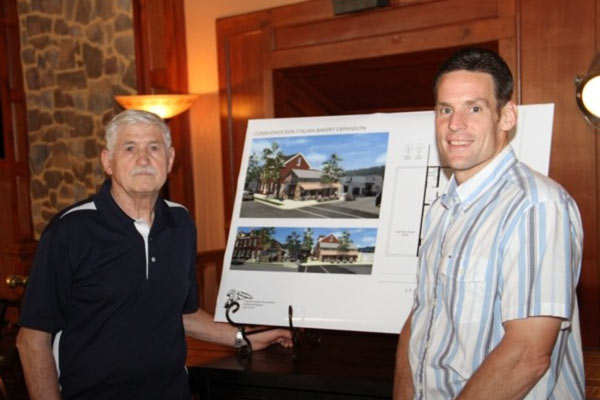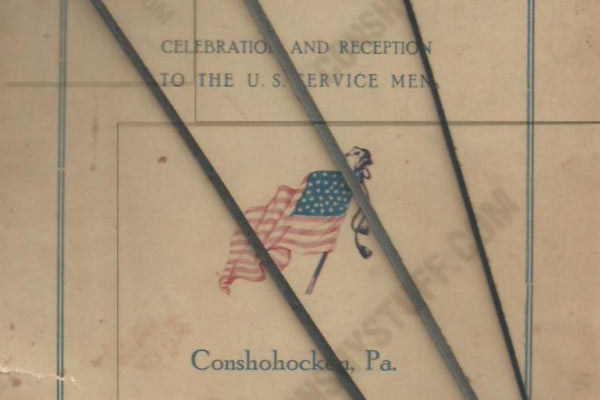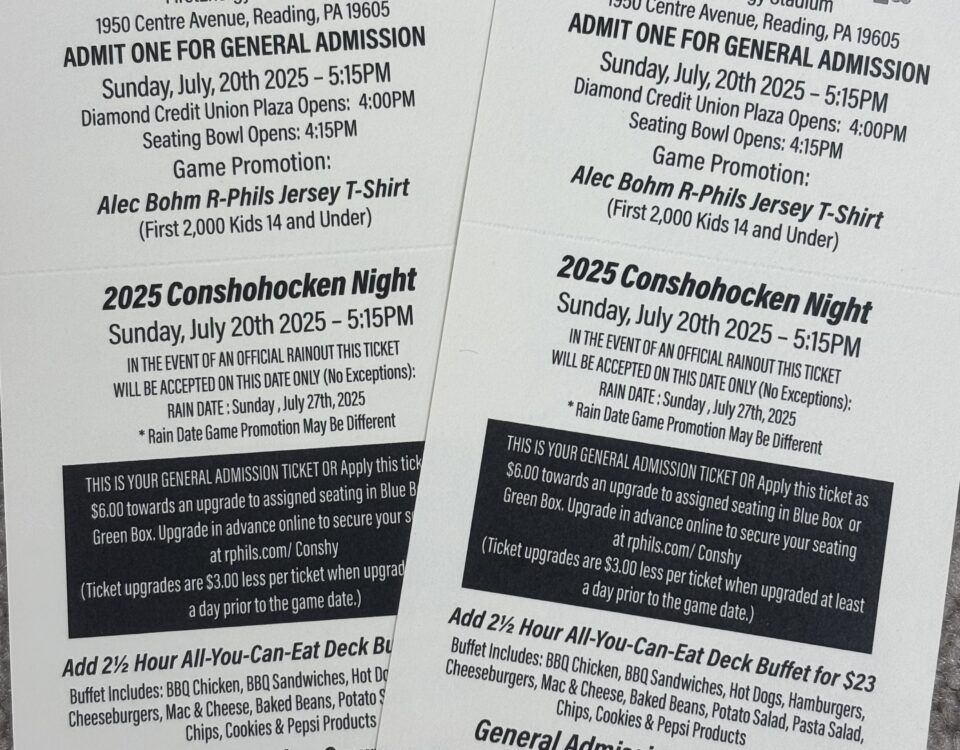
The Conshohocken Bakery; The Sweet Smell of an Addition by Jack Coll
June 26, 2014
Independence Day; Conshohocken Style by Jack Coll
July 1, 2014The Irish, West Conshohocken and St. Gertrude’s Church; by Jack Coll

THE IRISH, WEST CONSHOHOCKEN
AND ST. GERTRUDE’S CHURCH
By Jack Coll
Most towns in America have this wonderful history of people struggling to build a town, and most of those towns were founded on the backs of immigrants. The histories of our churches in America are the same, built step by step by a group of people who could hardly afford to keep food in the mouths of their family. And the people of this great country of ours continue to amaze me every time I open a book, the struggles, the determination, the backbones and the fight of the immigrants who came to this country looking for a little better life than what their own country was offering.
The borough of West Conshohocken incorporated in 1874, was and is the model American town built on the shoulders of these immigrants, and St. Gertrude’s Church was built on the backs of the hard working Irish immigrants.
The Irish immigrants who poured into Montgomery County in the early 1800’s were attracted to this area to fulfill labor jobs available for the construction of up and coming industries built along the river towns of Montgomery County. The building of the Schuylkill Canal in the early 1820’s drew many of the Irish who would eventually settle in the villages of Conshohocken and West Conshohocken. Following the successful construction of the canal, work began on the local railroads where Irish immigrants would help lay railroad ties and tracks.
With the completion of the canal and railroad many of the Irish remained in the area to work at the Alan Wood Steel mills, the many textiles plants to open especially in West Conshohocken, and also work the many stone quarries in the area.
Between 1810 and 1850 more than four million Irish made their way to this country due to centuries of political persecution and a long history of economic deprivation. In a very over-crowded country many of the Irish lived on small plots of ground paying an extremely high rent, unable to meet the demands of ever increasing rent, millions of the residents were evicted. By the 1840’s in Ireland blight struck the potato fields, hunger spread throughout the country and the need to survive sent millions of Irish to other parts of the world, many of the millions landed in the eastern part of the United States looking for any kind of labor jobs available.
Although the Irish lacked social and working skills, and most of them were illiterate, America was at the forefront of laying the economic industrial foundation, and that translated to plenty of jobs for the Irish. Despite finding jobs at the bottom rung of society the Irish were still regarded as the armpit of America, for nearly a hundred years to follow Help Wanted signs posted in store windows and in the offices of many of the labor jobs this country had to offer, the “Help Wanted” read big and bold underneath, “IRISH NEED NOT APPLY.”
Most of the Irish that fled the mother-land were predominantly Catholic, and would often gather on Sunday’s to support their beliefs and maintain a sense of community pride. Throughout the 1820’s and 1830’s Irish missionary priests from Philadelphia would visit the area for Sunday gatherings but as the Irish population grew along the Schuylkill River throughout Montgomery County the Catholics found a need to construct their own church. Norristown, incorporated in 1812 was a bustling borough with an established retail district on their Main Street and factory jobs not only along the river but throughout the borough. In 1835 a Catholic parish, St. Patrick’s was established giving high hopes throughout the rest of the county. Over the next two decades the Irish Americans established churches in Pottstown and Conshohocken.
Following the formation of St. Matthew’s Church in 1851, the West Conshohocken contingent of Irish Catholics continued to grow and visit and support St. Matthew’s. In 1888, West Conshohocken was a fully established town featuring Front and Ford Streets as the main retail district in the borough, most of those shops were owned and operated by Irish residents. Fourteen years after West Conshohocken was incorporated, (In 1874) in the spring of 1888, Archbishop John Patrick Ryan of Philadelphia decided it was time for West Conshohocken to have their own place of worship. It’s not quite clear as to why the name of the church is St. Gertrude’s, although one thought is the fact that the date of the establishment of the newly formed church was announced on November 15, 1888, the feast day of St. Gertrude. Boundaries of the church included the communities of West Conshohocken, Swedeland, parts of Lower Merion, Gulf Mills and parts of Upper Merion. More than 100 Catholic families were included in the district, because West Conshohocken was the most populated area of the district it was decided by the Philadelphia Archdiocese to build a church in West Conshohocken.
Notes from St. Gertrude’s Centennial Celebration booklet included:
Most of the land on which the church and the parking lot were built belonged originally to George Bullock. (George Bullock served as the borough’s first burgess from its incorporation in 1874 until 1888, the year the church was established.)
It took about three months to build the new church. Men of the parish including Darby Hushen, John McTamney and Jimmy Carr, assisted the contractor in working on the foundation, which was made of fine stone from Dougherty’s Quarry once located on River Road, later the site of the Allentown Cement Company. The beautiful stone mined at the quarry was known as Conshohocken or Merion Blue stone, a stone still visible in many of Philadelphia’s landmark buildings. The church was originally built with standard double sash windows. The beautiful stained-glass windows were installed within a year after the church was built, all windows were gifts of the parishioners.
The stained-glass windows were dedicated in the memory of the following parishioners:
Mr. and Mrs. Timothy Naylon
Mr. and Mrs. Patrick Dougherty
Mr. and Mrs. Charles McShane
Mr. and Mrs. Patrick Eagan
Mr. and Mrs. Cornelius Boyle
Mr. and Mrs. Felix O’Brien
Mr. and Mrs. William McNally
James O’Hara
Edward Britt
Peter Clinton
Rev. D. P. O’Connor
Windows in Gift presented by
Mr. and Mrs. Darby Hushen
Mr. and Mrs. P. F. Dugan
Gift of the Temperance Society
Gift of the Sodality of B. V. M.
According to the Catholic Standard and Times published on April 6, 1889, it was a late winter snowfall on the fourth Sunday in lent, March 31, 1889. Parishioners traveled by horse and buggy from the borough’s outer limits, some parishioners of course traveled by foot, fighting off the small drifts caused by the overnight winds running off the river and down from the hilltop. On this cold, snowy Sunday St. Gertrude’s Church was to be dedicated with grand ceremonies starting at 10:30 a.m. According the Standard and Times Rev. O’Connor, the rector of the new parish, rallied a number of men of the congregation, and walked to the West Conshohocken train depot to meet and escort from the train the Archbishop. The line of men walked down the hill, past Bullock’s Row, along the snow covered Front Street. Upon their arrival back at the church the Archbishop was met by a standing room only crowd of parishioners as church dedication services began. As the horses and wagons were hitched to posts up and down the streets surrounding the church the scene was reminiscence of a Burl and Ives magazine cover. A beautiful choir led by organist Teresa Vallaly filled the new church with a warm elegance never before heard in the young borough.
The Standard and Times called St. Gertrude’s a “tasteful and substantial frame structure…undoubtedly the handsomest and best appointed structure of its kind in the archdiocese.”
It also was the only church in the Archdiocese with electric lighting, which provided a “bright, yet mild and steady light” that “showed the new church to its best advantage.”
On that very same day, March 31, 1889, the first baptism was performed. Anna Elizabeth Kay, the daughter of William Kay and Roseanne (Clark) Kay. Just two and a half months later on June 11, 1889, John F. Powers married Margaret Carr. Michael Carr and Catherine Ryan witnessed the ceremony, it was St. Gertrude’s first wedding.
A segment from the St. Gertrude’s 100th Anniversary Book reads:
Ethnic Parishes
“The developing ethnic character of the Catholic immigration from
Europe necessitated the formation of the ethnic parishes, primarily
for the language reasons. These were parishes without strict territorial
boundaries, which any member of the designated ethnic group could
join if he or she so desired. The first, in this area, in 1899 was the Slovak
parish in Pottstown, called Holy Trinity, followed in 1903 by an Italian
congregation, Holy Saviour, Norristown and then St. Mary in 1905, a Polish
congregation in Conshohocken who had previously worshipped at
St. Josephat’s in Manayunk. In the 1920’s a large number of Slovaks
settled in Swedeland and established a congregation which by 1926
was holding services in the Bridgeport Bonnet factory until
Our Mother of Sorrows Church was completed in 1928. The Irish,
since they spoke English (though with a deep brogue) became
almost the sole members of St. Gertrude’s, the ‘terri-torial’
parish which soon became known as the “Irish” Church.
And so it is, 125 years of service, dedication and worship, a hundred and twenty five years of Boy Scouts, Girl Scouts, the St. Gertrude’s CYO programs for both boys and girls, they certainly left a number of memorable moments on and off the court. One hundred and twenty five years of the church choir, the woman’s clubs, and the men’s clubs, the opening and closing of the school. One hundred and twenty five years of May Processions, parish picnics and endless nights that involved thousands of parishioners working in the church basement for one reason or another.
Right now, the very minute you are reading this, parishioners throughout the Philadelphia area are hurting, all asking the same question, why our church? While we all appreciate the church, the former school, the convent, the rectory, and even a hundred and twenty five years of events, as the St. Gertrude’s Centennial Book states, the reason this parish was established in the first place, what they called the invisible history, “the spiritual life of the parish.” We have a tendency to look back on the physical life of the church.
The thing is St. Gertrude’s Church was established to provide for the spiritual needs not only by the founding members, but all the members and families who have chosen to worship at St. Gertrude’s since its formation. Perhaps the success of the church will forever be known as the many parishioners in the community have found spiritual healing throughout the years thanks in part to St. Gertrude’s.
I grew up in a pretty tough part of Philadelphia, one of the things I learned early on was the American Irish population was, and is a pretty tough breed, I learned they could take a punch, they could bounce back, they didn’t go away, and when they did come back they were tougher, more determined than ever to accomplish any given goal.
I don’t think the closing of a church will knock them out of the box.
Yea, dem Irish are a pretty tough breed!
Hey, St. Gert’s, thanks for the memories, from horses and wagons and dirt roads, to World War One, you saw us through a depression, World War Two, Korea, and the assassination of a president of the United States. You spiritually guided us through more than 125 years of floods along our Schuylkill River, you look down on the great fire of 1971, and while we lost one fireman and several residents, thanks to your spiritual blessings and the resident’s prayers, we did save lives, it could have been a whole lot worse. Thanks for your blessings in Vietnam, and all the other foreign countries we have chosen to send our sons and daughters into.
I think St. Gert’s has seen us through, I think St. Gert’s has blessed the minds and souls of everyone that has come in contact with the church for the past 125 years.
I think we can all go in peace. And I think the Lord will bless each and every one of our souls
God Bless West Conshohocken
Material for this column came from
Montgomery County, The Second Hundred Years
Church of St. Gertrude….100th Anniversary
West Conshohocken Celebration booklets
And the files of Jack Coll

